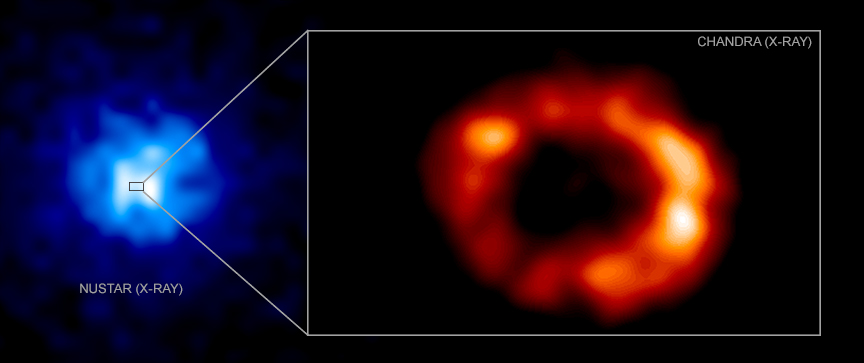
In theory, a supernova should go off in a galaxy like ours about every one hundred years. Frustratingly, we haven’t seen one in a lot longer than one hundred years. This could be because supernovae have been going off in hidden places, for instance on the other of the center of the galaxy or behind one of the dark molecular clouds where stars like to form. No matter what’s going on, a nearby supernova hasn’t been in our galaxy’s cards, and the best we have had is supernova 1987A in the nearby Large Magellanic Cloud, which is actually a galaxy imitating a cloud as seen from the southern hemisphere.
First appearing on February 24, 1987, astronomers have been able to track its evolution in glorious detail, and this year one particularly-looked-for detail has started to let itself be seen, sort of. SN1987A is the result of a massive star running out of fuel in its core. When this happened, the core collapsed, in theory, into a neutron star, and the outer layers bounced away to form the nebula we see today. The thing is that for the past 34 years, no one has been able to see a neutron star in this system. To be fair, it’s still a mess of gas and light and debris that we can’t see through with our telescopes. It’s expected that when we can clearly see that collapsed core, we’ll find it rapidly spinning like a pulsar. For now, though, we can’t see it directly, but using a suite of modern telescopes, a team has detected what appear to be the effects of a pulsar spinning in the middle of that mess.
This is pretty extraordinary. That spinning neutron star should be about ten miles across and have mass several times the mass of the Sun. We are literally looking for an object about the diameter of Manhattan that is located 168,000 light-years from Earth. Luckily, this small object can put on an amazing show.
This show, unfortunately, is in colors of light our eyes can’t see. This team looked at SN1987A in the X-ray with Chandra and NuSTAR and in longer wavelengths with ALMA. Their results, published in The Astrophysical Journal this week with lead author Emanuele Greco, show a mix of high energy X-rays, brightening radio emissions, and other behaviors consistent with a neutron star spinning in the center of the supernova remnant.
According to coauthor Marco Miceli: Astronomers have wondered if not enough time has passed for a pulsar to form, or even if SN 1987A created a black hole. This has been an ongoing mystery for a few decades and we are very excited to bring new information to the table with this result.
Alcatore Orlando adds: Being able to watch a pulsar essentially since its birth would be unprecedented. It might be a once-in-a-lifetime opportunity to study the development of a baby pulsar.
The birth and evolution of pulsars is something that occurs on human time scales. SN1987A is a Millennial, and it has been watched as it matures by the Boomer astronomers. By the time the Zoomers are running the astronomy community, that pulsar should be a lot easier to detect, and over the next several generations, astronomers on Earth will be able to watch the pulsar emerge from behind the spreading debris and even slowly change in its rotation rate. I fully expect our technology to advance in unimaginable ways over these generations, but even though our current data may be seen as primitive, it’s well-calibrated, accurate data, and this will be the first time we’ve been able to digitally measure a supernova, its central remnant, and how it all changes over time.
The closest we have to this is the 1604 explosion that formed the Crab Nebula. Described by the likes of Johannes Kepler and Johannes van Heeck, that event was documented with drawings and written comparisons of its brightness to that of other stars. While this data is awesome, and the nearness of the system allows us to readily measure its continued expansion, this isn’t the same.
I’m still holding out hope for a visible light supernova in our galaxy, but until that happens, we have SN1987A, and today, 34 years and one day after we first spotted it, we can say hello to the pulsar spinning in its core.
More Information
Chandra X-ray Observatory press release
“Indication of a Pulsar Wind Nebula in the hard X-ray emission from SN 1987A,” Emanuele Greco et al., to be published in The Astrophysical Journal (preprint on arxiv.org)




 Join the Crew!
Join the Crew!
 Escape Velocity Space News
Escape Velocity Space News
0 Comments